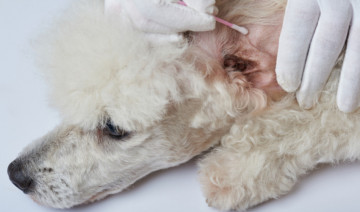
Ear and Skin Yeast Infections in Dogs
Yeast infections can be very troubling for pets, causing discomfort and possibly leading to more serious infections and complications. Knowing how to manage ear and skin yeast infections in dogs can help pet owners keep their dogs comfortable and healthy.
What Is a Yeast Infection?
Yeast fungus is naturally present on a dog’s skin and in their ears. When a dog’s body chemistry is balanced and the animal is healthy, yeast poses no difficulties, but when yeast begins to grow uncontrollably due to poor health or prime growth conditions, it can cause infections. Yeast grows best in warm, humid environments, and yeast infections are more common during the summer months. All dogs can develop yeast infections, but breeds with heavy, droopy ears, fur growing inside the ear canal, or excess folds of skin are more prone to these infections. Breeds that develop more yeast infections include:
- Basset hounds
- Cocker spaniels
- Dachshunds
- Golden retrievers
- Malteses
- Poodles
- Setters
- Shar peis
- Shih tzus
- West Highland white terriers
Yeast infections may appear spontaneously, but are more often secondary infections related to other health problems. Some dogs have yeast or food allergies that can lead to easier yeast infections, while health conditions such as diabetes, thyroid disease, or immunodeficiencies can make dogs more prone to yeast infections. Dogs that are frequent swimmers or that are bathed more often can also have more yeast infections, as can any dog with poor ear or coat hygiene.
Yeast Infection Symptoms
No matter why a dog may develop a yeast infection, the symptoms will be similar. Depending on where the yeast fungus is growing, symptoms of the infection may include:
- Red, irritated skin that may seem greasy, scaly, or flaky
- Excessive itching or biting at skin
- Strong ear odor, especially a musty odor
- Swollen or inflamed ears or paw pads
- Excessive waxy, dark red or brown ear discharge
- Hair loss or broken fur
- Head shaking or rubbing
- Hearing loss
- Loss of balance
Yeast infections can occur anywhere on a dog’s body, but are most common in the ears or on the paw pads, or in folds of skin around the neck, face, or groin.
Treating Yeast Infections in Dogs
Before treatment begins, it is important to get a confirmed diagnosis from a veterinarian, since the symptoms of a yeast infection could also be caused by ear mites. An ear swab, skin swab, or blood test can confirm a yeast infection, and depending on the severity of the infection or its underlying cause, the veterinarian can prescribe appropriate medications and treatments. Options include:
- Oral antibiotics
- Topical treatments, such as drops, sprays, wipes, or ointments
- Anti-inflammatory medication
The underlying cause of the infection must be treated. For example, tumors in the ear canal can create prime conditions for a yeast infection, but the tumor must be removed or treated or else the yeast infection can easily recur. Similarly, if food allergies are causing the yeast imbalance, a change in diet will be necessary to calm the infection.
Prevention Tips
Yeast infections can be easy to prevent or minimize. Keeping a dog’s ears and paws healthy and dry is critical, especially after swimming or bathing. Carefully trim any fur growing in the dog’s ear canal to promote better air circulation, and clean the dog’s ears carefully as part of regular grooming. Likewise, trim fur around the dog’s paws so they stay cleaner and drier.
Providing a healthy-skin diet can help a dog maintain its regular balance of skin chemistry. Good brushing and grooming will remove dead skin, hair, and dirt from the dog’s skin, promoting healthier skin and reducing the likelihood of yeast infections. Coat-grooming tools, including brushes, should also be cleaned and disinfected regularly, especially if they are used on multiple pets, and the dog’s bedding should be kept clean and dry.
While any dog may occasionally develop an ear or skin yeast infection, understanding what these infections are and knowing how to minimize them can keep your pet much more comfortable.
